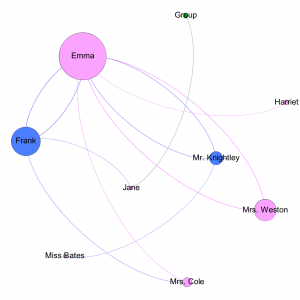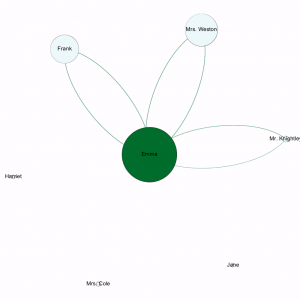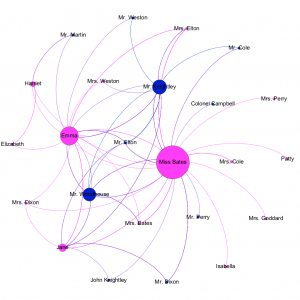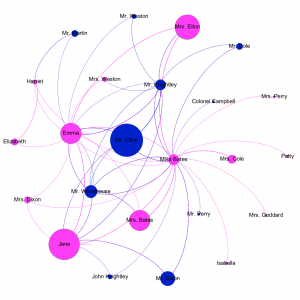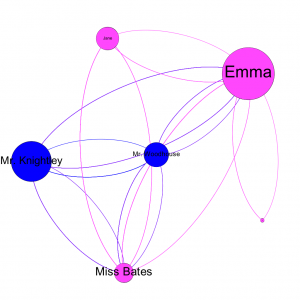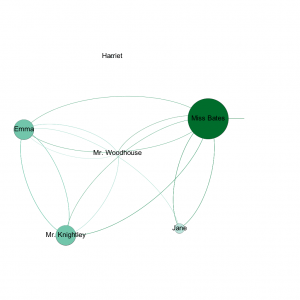Letters
Letters are a significant mode of transferring information in Austen’s novels. Although characters more often gossip through face-to-face speech, letters allow them to correspond with people in other locations as well as with those in Highbury. Some letters arrive in Highbury from outside, bringing news from faraway places, such as the actions and wellbeing of Frank Churchill or Jane Fairfax. Others are more insular, bringing important news to members of the community, like Mr. Martin’s proposal to Harriet Smith. The delivery of a letter draws attention to its contents in a way that speech does not allow, and a letter allows the writer to provide a more thorough explanation of their thoughts than they could aloud. Additionally, letters introduce a physical network to our understanding of gossip in the form of the postal service. Although barely visible in the novels, the delivery of letters relies on a postal system to move letters from the source to the destination. This hidden physical network is essential to the delivery of letters, even if we do not see it explicitly in the book. Without the postal system, the circulation of information within and to Highbury as we see it would be impossible.
Although apparently a physical medium, letters often blur the lines between physical and oral. Although one might generally assume that one person writes a letter and sends it to another, characters often share the contents of letters with one another, even reading their letters aloud. For example, Miss Bates delights in sharing the contents of her letters from Jane Fairfax with the whole of Highbury. Jane’s letters, though addressed to Miss Bates, surely are not only meant for her eyes. We may suppose that Jane knows the extent to which her aunt likes to gossip and ensures that the contents of her letters are such that having them shared would be no great embarrassment. Further, the contents of a letter may make it unclear exactly for whom it is intended. When Mr. Elton delivers his written “charade” to Hartfield, he intends to direct it to Emma. However, she believes that he is courting her friend Harriet Smith and delivers the charade to her instead. Because the charade, which we might think of as a type of letter, is addressed only to the ambiguous “Miss – ”, Emma is left to interpret it as she chooses, and she does so incorrectly.
Further, characters often share information they gain through letters aloud, mixing communication through letter with verbal communication. Some letters we receive in their entirety, like Mr. Elton’s charade. Others we receive exclusively through speech or description. Mr. Churchill’s letters home, for instance, never appear in the text, but Mr. and Mrs. Weston are more than happy to share the general messages within them. In fact, for a large part of their lives, the only way that Highbury hears about Jane Fairfax or Frank Churchill is through letters. Letters, then, are intrinsically linked to speech. The written words of one character end up in the hands of another and percolate throughout the town through conversation. In one particular occasion, Emma, the Westons, and the Knightleys discuss the quality of Mr. Churchill’s handwriting, but Mrs. Weston is unable to produce a sample as she does not have one of his letters with her. In this case, the contents of the letter are far less important than its physical aspects. The characters have presumably seen and read at least one of Mr. Churchill’s letters, but the physicality is more notable than any news it may contain.
Early in the project, I intended to much more closely consider the role of letters in Emma. I hoped to incorporate them in the graph in some way and study the role of physical communication in the network of the novel as a whole. However, I eventually abandoned this idea due to time constraints and the richness of information available in the dialogue-based graphs. Letters certainly play a significant role in the gossip of Highbury, as discussed above, and this would be a promising avenue of study for future work. Although I did not examine the role of letters as explicitly as I had hoped, they are relevant to both of the individual chapters of focus.
Free Indirect Discourse
Scholars have previously drawn a connection between gossip and free indirect discourse, and I initially intended to draw such a connection in my own project. As Finch and Bowen write:
“The very force of free indirect style is the force of gossip. Both function as forms par excellence of surveillance, and both serve ultimately to locate the subject – characterological or political – within a seemingly benign but ultimately coercive narrative or social matrix. It is no coincidence that the first great novelist of gossip should also be the first great technician of the free indirect style.” (Finch, 3-4)
According to Finch and Bowen, free indirect discourse is parallel to gossip in that it makes the private public. Just as gossip displaces its authority throughout the community, so does free indirect discourse conceal its source. Austen uses free indirect discourse to make the private known, to share with us the interiority of her characters. Additionally, because of gossip, “there is nothing, however seemingly private, that is not somehow already illuminated by the normalizing light of public scrutiny,” (Finch, 2). Free indirect discourse simultaneously shares with us the minds of the characters while also obscuring the truth. For much of the novel, we are too entrenched in Emma’s perspective to fully see what is happening around her. Just as Emma is blind to the desires of her friends, so are we. For instance, Austen hints at the hidden relationship between Jane Fairfax and Frank Churchill, but we are too entrenched in Emma’s perspective to see those signs. Free indirect discourse, then, is intrinsically linked with gossip in its ability to simultaneously share the truth and obscure it. When the study of free indirect discourse was a more prominent part of my project, I found the project Austen Said, which visualizes the occurrences of free indirect discourse in Austen’s novels by certainty. Although I did not end up working with free indirect discourse, I did use their XML documentation of Emma as the basis for my own work with the novel.
